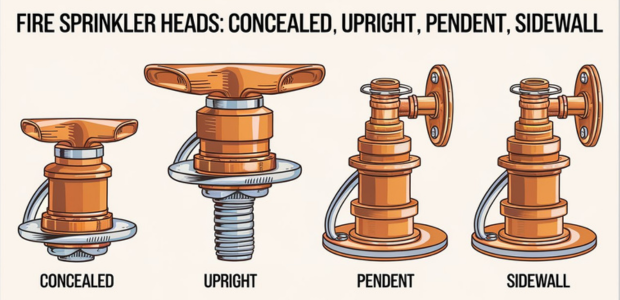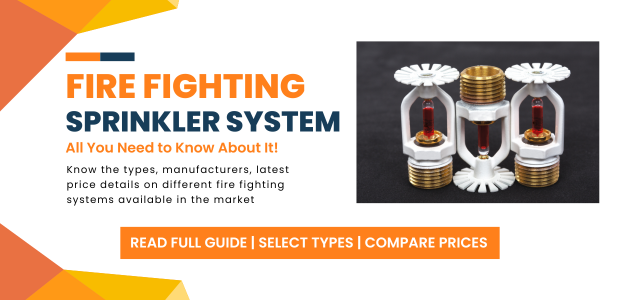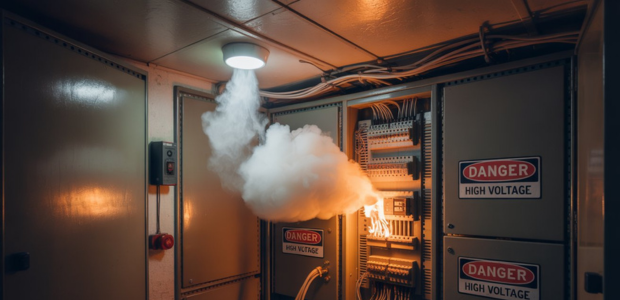Types of Fire Sprinkler Heads: Parts & Differences

- May 16, 2025
- Interface Digital
- When it comes to fire protection in homes, offices, or commercial spaces, fire sprinkler systems are one of the most reliable first lines of defense. At the heart of these systems are the fire sprinkler heads — those small, sometimes barely noticeable components in the ceiling or wall that can literally save lives and property in case of fire.
- But did you know there are different types of fire sprinkler heads, each designed for a specific purpose or setting? In this blog, we’ll explore everything you need to know about them, from the various types, how they work, their parts, ratings, to how often they need to be replaced.
About Fire Sprinkler Heads
- A fire sprinkler head is a sprinkler system component that releases water when it senses a fire, usually by heat. They’re triggered individually, not all at once (a common movie myth!), and are designed to suppress fires in the early stages.
- Depending on the design, location, and use of the building, there are specific types of fire sprinkler heads to meet different needs. From commercial kitchens to hotel rooms and warehouses, sprinkler heads vary in appearance and function.
Types of Fire Sprinkler Heads
1. Concealed Fire Sprinkler Heads
- A concealed pendent may be utilized to integrate a fire sprinkler head within your ceiling's aesthetics while maintaining its functioning.
- This cover, which may be removed when temperatures fall 20 degrees below the activation temperature, keeps the recessed fire sprinkler head operational and is removed once temperatures reach the appropriate level.
- Where is it used: Hotels, high-end residential buildings, offices
- Benefits:
- Aesthetic appeal
- Protects sprinkler from dust or accidental tampering
- Great for drop ceilings and designer spaces
2. Upright Fire Sprinkler Heads
- Upright fire sprinkler heads, positioned on pipes beneath the ceiling, spray water in a dome-shaped or oval pattern, which makes them useful in inaccessible areas such as industrial facilities and warehouses.
- They are installed on pipes below the ceiling and shielded by a deflector to avoid ice and debris accumulation.
- Benefits:
- Less prone to mechanical damage
- Ideal for areas with obstructions or hard-to-reach ceilings
3. Pendent Sprinkler Heads
- The pendent is a common type of sprinkler head that descends from the ceiling with a convex deflector plate. It sends water into other deflectors when activated, dispersing water in a conical pattern.
- The pendant provides the greatest coverage, extending from the ceiling, and is effective in protecting various spaces and buildings, including daycares and industrial buildings.
- Where is it used: Offices, hotels, residential buildings
- Benefits:
- Wide coverage
- Easy installation
- Effective for spaces with finished ceilings
4. Sidewall Sprinkler Head
- Sidewall fire sprinkler heads, which have a solid, semi-circular, or rectangular deflector plate, give more water coverage and are good for narrow spaces such as obstacle areas without ceiling pipes and corridors because they send water into open areas.
- Where is it used: Small rooms, hallways, hotels, and apartments
- Benefits:
- Ideal for areas without ceiling access
- Cost-effective for retrofits or unusual layouts
- Each of these types of fire sprinkler heads has specific applications, and using the right one is essential for optimal fire protection.
How Do Fire Sprinkler Heads Work?
Fire sprinklers are often closed by a fusible metal link or a tiny glass bulb containing a heat-sensitive liquid. Each of these trigger systems keeps the pip cap, also referred to as the "plug," in position. The most popular variety is glass bulbs that contain a glycerin-based liquid. When a fire starts, hot air is directed into the sprinkler heads, and when the temperature reaches a particular degree, the liquid expands, causing the glass to shatter. A wet sprinkler system shoots pressure water onto a deflector plate until the primary valve closes or the water supply dries up. The commercial fire sprinkler head replacement cost in India comes between Rs 500 to Rs 2,000.- There are few things that people do not know:
- Only the sprinkler head that is nearest to the fire gets activated. But not the entire system.
- The system must always be connected to a constant water supply or a pressurized tank.
Parts of a Fire Sprinkler Head
- A fire extinguisher with sprinkler head includes pipes, sprinkler heads, gauges, control valves, a water flow alarm, and an auxiliary drain.
- The pipelines transmit pressurized water to sprinkler heads, which are activated by smoke or heat.
- The gauges monitor water pressure, while the control valves regulate flow. The water flow alarm identifies leaks, while the auxiliary drain keeps low places from freezing.
- Finally, these components function together to detect fires quickly and effectively by sending pressurized water to the damaged area at a set pace.
Fire Sprinkler K-Factor
- One of the more technical (but essential) elements in sprinkler design is the K-factor.
- The K-factor measures the discharge rate of a sprinkler head. It’s calculated using this formula:
- Q = K√P
- Where:
- Q = Flow rate (gallons per minute, GPM)
- K = K-Factor (a constant unique to the sprinkler)
- P = Pressure (pounds per square inch, PSI)
- A higher K-Factor means more water can be released at a given pressure. Different types of fire sprinkler heads have different K-Factors based on their application. For example:
- Light hazard areas: K = 5.6
- Extra hazard areas: K = 8.0 or more
Fire Sprinkler Heads Temperature Ratings
Sprinkler heads have temperature ratings and are designated according to sprinkler head colour code. Below we have breakdown ratings and colour codes:- Celsius for orange is 57°C and Fahrenheit is 135
- Celsius for Red is 68°C and Fahrenheit is 155
- Celsius for Yellow is 79°C and Fahrenheit is 174
- Celsius for Green is 93°C and Fahrenheit is 200
- Celsius for Blue is 141°C and Fahrenheit is 286
- Celsius for Mauve is 182°C and Fahrenheit is 360
- Celsius for Black is 227/260°C and Fahrenheit is 440/500
- Celsius for orange is 57°C and Fahrenheit is 135
Fire Sprinkler Head Life Expectancy
Fire sprinkler heads are durable, but not immortal. Here’s what to keep in mind:- Standard sprinkler heads: These sprinkler heads usually last 50 years.
- Fast-response sprinklers: This type of sprinkler lasts up to 20 years.
- Dry sprinkler heads: Should be replaced every 10 years due to a higher corrosion risk.
Fire Sprinkler Head Replacement/Installation
- Need to replace or install fire sprinkler heads? Here's what to know:
- Assessment: Identify the type needed — concealed, upright, pendent, or sidewall.
- Turn off the water supply: Prevent accidental flooding during installation.
- Remove the old head carefully: Use a wrench and avoid damaging the piping.
- Install new head: Screw it in, ensuring proper alignment and seal.
- Test system: Once installed, pressure-test to confirm no leaks.
Partner with Interface Digital Solutions
- Whether you're designing a new fire safety system or retrofitting an older building, Interface Digital Solutions is your trusted partner. We follow code compliance and safety standards.
- We offer advanced fire detection and suppression solutions, including expert installation of all types of fire sprinkler heads. These products are:
- Beam detectors
- Smoke detectors
- Heat detectors
- Fire sensors
- Fire alarm control panel
- Fire alarm monitoring
- Fire alarm inspection
- Fire alarm maintenance
- Fire alarm notification
- Fire Hydrant
- IOT Rack Suppression
- Novec Cylinder
FAQ
Q1. How to replace a fire sprinkler head?
Find the fire sprinkler water valve, turn the handle clockwise, remove the cap, apply anaerobic pipe thread sealant, attach the head, reconnect the water valve, and test the sprinklers as recommended.Q2. How to turn off a fire sprinkler head?
To turn off the sprinkler system's water flow, slowly but steadily rotate the control valve clockwise.Q3. What is the Distance between fire sprinkler heads?
The maximum distance between fire sprinkler heads is 12 feet (3.7 meters).Q4. How many fire sprinkler heads per line?
According to NFPA 13, a fire sprinkler system may typically support up to eight sprinkler heads per branch line. Sometimes you can also support up to 9 to 10 fire sprinkler heads.Q5. How often do fire sprinkler heads need to be replaced?
It is recommended that standard heads be changed every 50 years, dry heads every 10 years, and quick response heads every 20 years. If a head is broken, painted, or leaks, it should be replaced right away.Q6. Can you move fire sprinkler heads?
Yes, you can move fire sprinkler heads, but doing so could call for professional knowledge and adherence to fire safety regulations, therefore a qualified fire protection contractor may be needed for safety.Q7. How to clean fire sprinkler heads?
To effectively clean fire sprinkler heads, use a soft cloth or brush and a light cleaning solution, such as dish soap or diluted vinegar.Q8. Minimum distance between fire sprinkler heads?
It is recommended that fire sprinkler heads be at least six feet apart.Conclusion
- Fire sprinkler systems are vital safety installations, and at the heart of them are the unsung heroes — the fire sprinkler heads.
- Knowing the differences between types of fire sprinkler heads, understanding their parts, operation, and maintenance can make all the difference when it comes to protecting your space and the people in it.
- Whether you're an architect, business owner, or just curious about your home’s safety, keep this guide handy — and remember to always consult professionals like Interface Digital Solutions for any design, installation, or maintenance services.
- Want to learn more or book an inspection? Reach out today and keep your property safe, compliant, and protected 24/7.
Also read: Types of Fire Detection & Alarm Systems: A Brief Guide








